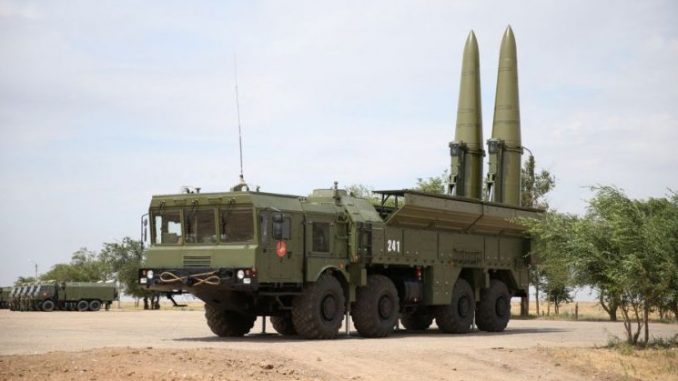
Russia is planning to station advanced nuclear-capable ballistic missiles deep inside Europe in response to the U.S. backed missile defense shield in Eastern Europe.
The Iskander short range ballistic missile (NATO designation SS-26 Stone) is to be deployed to the Russian Baltic enclave of Kaliningrad that sits between Poland and Lithuania.

BYPASS THE CENSORS
Sign up to get unfiltered news delivered straight to your inbox.
You can unsubscribe any time. By subscribing you agree to our Terms of Use
Latest Video
Vast swathes of Europe could come under the range of the nuclear-capable Iskander.
The Daily Express reports:
Crimea, which was annexed from the Ukraine in 2014, could also host a second Iskander missile base, Russian defence sources claim.
Russia has been accused of blatant acts of aggression in eastern Europe and the Baltics, with land grabs, military exercises and close fly-bys of its fighter jets.
The move is in defiance of a US-backed Nato missile shield that was erected in Romania last month, with a second planned for Poland in 2018.
With a range of roughly 300 miles, the Iskander missile could hit targets as far away as eastern Germany, the entire Baltic region and Poland, as well as parts of Sweden.
But experts say the targets it will cover can be struck by longer-range Russian missiles anyway.
Relations between Russia and the West have plunged to their lowest point since the Cold War in recent months.
Both sides have ramped up their defence spending, missile programmes and defensive shields as Europe enters what many observers believe is a new Cold War.
However, Russian and Western experts say the US-backed shield in Romania may simply have given the Kremlin the political cover it needs to justify stationing nuclear-capable missiles in central Europe – something it was planning all along.
Steven Pifer, a former US ambassador to Ukraine, said there was a “long history in Moscow of saying what they’re doing is in response to what you guys did, even though they planned it in advance”.
Moscow is thought likely to wait until the planned Polish missile defence site opens in two years time before it unveils a more serious response.
The Kremlin has often threatened to put nuclear-capable missiles in Kaliningrad as a riposte to the shield.
Mikhail Barabanov, a senior research fellow at the Moscow-based Centre for Analysis of Strategies and Technologies, which advises the Russian Defence Ministry, said it was now “inevitable” that the Kremlin would deploy the missiles there permanently by 2019.
The Iskander, a mobile ballistic missile system codenamed SS-26 Stone by north Atlantic military alliance which replaced the Soviet Scud missile and can carry conventional or nuclear warheads.
Iskander missiles have been deployed twice by Russia on exercises in Kaliningrad – but on both occasions they are believed to have been withdrawn.
Defence minister Sergei Shoigu has threatened to deploy the Iskander anywhere in Russia and other senior military officials have said Kaliningrad will get the Iskanders in the next few years as part of a routine nationwide upgrade.
Moscow also recently announced plans to restore an ageing missile defence system near the Black Sea.
The Soviet-era relic near Sevastopol will be used to protect Russia from rocket attacks launched from locations in the Middle East, including Turkey and Syria.
Dnepr base will be equipped to intercept ballistic, cruise and hypersonic missiles at a range of around 2,000 miles.
The vast complex has not been used for 10 years but fell back under the Kremlin’s control when Russia annexed Crimea.


